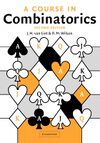组合数学 (Spring 2025): Difference between revisions
Jump to navigation
Jump to search
No edit summary |
|||
| Line 1: | Line 1: | ||
{{Infobox | |||
|name = Infobox | |||
|bodystyle = | |||
|title = <font size=3>组合数学 <br> | |||
Combinatorics</font> | |||
|titlestyle = | |||
This is the webpage for the ''Combinatorics'' class of Spring 2024. Students who take this class should check this page periodically for content updates and new announcements. | |image = | ||
|imagestyle = | |||
|caption = | |||
|captionstyle = | |||
|headerstyle = background:#ccf; | |||
|labelstyle = background:#ddf; | |||
|datastyle = | |||
|header1 =Instructor | |||
|label1 = | |||
|data1 = | |||
|header2 = | |||
|label2 = | |||
|data2 = 尹一通 | |||
|header3 = | |||
|label3 = Email | |||
|data3 = yinyt@nju.edu.cn | |||
|header4 = | |||
|label4= office | |||
|data4= 计算机系 804 | |||
|header5 = Class | |||
|label5 = | |||
|data5 = | |||
|header6 = | |||
|label6 = Class meetings | |||
|data6 = Wednesday, 2pm-4pm <br> 仙Ⅱ-211 | |||
|header7 = | |||
|label7 = Place | |||
|data7 = | |||
|header8 = | |||
|label8 = Office hours | |||
|data8 = TBA <br>计算机系 804 | |||
|header9 = Textbook | |||
|label9 = | |||
|data9 = | |||
|header10 = | |||
|label10 = | |||
|data10 = [[File:LW-combinatorics.jpeg|border|100px]] | |||
|header11 = | |||
|label11 = | |||
|data11 = van Lint and Wilson. <br> ''A course in Combinatorics, 2nd ed.'', <br> Cambridge Univ Press, 2001. | |||
|header12 = | |||
|label12 = | |||
|data12 = [[File:Jukna_book.jpg|border|100px]] | |||
|header13 = | |||
|label13 = | |||
|data13 = Jukna. ''Extremal Combinatorics: <br> With Applications in Computer Science,<br>2nd ed.'', Springer, 2011. | |||
|belowstyle = background:#ddf; | |||
|below = | |||
}} | |||
This is the webpage for the ''Combinatorics'' class of Spring 2024. Students who take this class should check this page periodically for content updates and new announcements. | |||
= Announcement = | = Announcement = | ||
= Course info = | = Course info = | ||
* '''Instructor ''': 尹一通 ([http://tcs.nju.edu.cn/yinyt/ homepage]) | * '''Instructor ''': 尹一通 ([http://tcs.nju.edu.cn/yinyt/ homepage]) | ||
:*'''email''': yinyt@nju.edu.cn | |||
:* '''email''': yinyt@nju.edu.cn | :*'''office''': 计算机系 804 | ||
:* '''office''': 计算机系 804 | |||
* '''Teaching assistant''': | * '''Teaching assistant''': | ||
** [https://lhy-gispzjz.github.io | ** [https://lhy-gispzjz.github.io 刘弘洋] ([mailto:liuhongyang@smail.nju.edu.cn liuhongyang@smail.nju.edu.cn]) | ||
** 丁天行 | ** [丁天行] | ||
* '''Class meeting''': Wednesday, 2pm-4pm, 逸A-322. | * '''Class meeting''': Wednesday, 2pm-4pm, 逸A-322. | ||
* '''Office hour''': TBA | * '''Office hour''': TBA | ||
:* '''QQ群''': TBA (加入时需报姓名、专业、学号) | :* '''QQ群''': TBA (加入时需报姓名、专业、学号) | ||
| Line 22: | Line 75: | ||
=== 先修课程 Prerequisites === | === 先修课程 Prerequisites === | ||
* 离散数学(Discrete Mathematics) | * 离散数学(Discrete Mathematics) | ||
* 线性代数(Linear Algebra) | * 线性代数(Linear Algebra) | ||
| Line 28: | Line 80: | ||
=== Course materials === | === Course materials === | ||
* [[组合数学 (Spring 2024)/Course materials|<font size=3>教材和参考书清单</font>]] | |||
* [ | |||
=== 成绩 Grades === | === 成绩 Grades === | ||
* 课程成绩:本课程将会有若干次作业和一次期末考试。最终成绩将由平时作业成绩 (≥ 60%) 和期末考试成绩 (≤ 40%) 综合得出。 | * 课程成绩:本课程将会有若干次作业和一次期末考试。最终成绩将由平时作业成绩 (≥ 60%) 和期末考试成绩 (≤ 40%) 综合得出。 | ||
* 迟交:如果有特殊的理由,无法按时完成作业,请提前联系授课老师,给出正当理由。否则迟交的作业将不被接受。 | * 迟交:如果有特殊的理由,无法按时完成作业,请提前联系授课老师,给出正当理由。否则迟交的作业将不被接受。 | ||
=== <font color= | === <font color=red> 学术诚信 Academic Integrity </font>=== | ||
学术诚信是所有从事学术活动的学生和学者最基本的职业道德底线,本课程将不遗余力的维护学术诚信规范,违反这一底线的行为将不会被容忍。 | 学术诚信是所有从事学术活动的学生和学者最基本的职业道德底线,本课程将不遗余力的维护学术诚信规范,违反这一底线的行为将不会被容忍。 | ||
作业完成的原则:署你名字的工作必须是你个人的贡献。在完成作业的过程中,允许讨论,前提是讨论的所有参与者均处于同等完成度。但关键想法的执行、以及作业文本的写作必须独立完成,并在作业中致谢(acknowledge)所有参与讨论的人。不允许其他任何形式的合作——尤其是与已经完成作业的同学“讨论”。 | 作业完成的原则:署你名字的工作必须是你个人的贡献。在完成作业的过程中,允许讨论,前提是讨论的所有参与者均处于同等完成度。但关键想法的执行、以及作业文本的写作必须独立完成,并在作业中致谢(acknowledge)所有参与讨论的人。不允许其他任何形式的合作——尤其是与已经完成作业的同学“讨论”。 | ||
本课程将对剽窃行为采取零容忍的态度。在完成作业过程中,对他人工作(出版物、互联网资料、其他人的作业等)直接的文本抄袭和对关键思想、关键元素的抄袭,按照 [http://www.acm.org/publications/policies/plagiarism_policy ACM Policy on Plagiarism]的解释,都将视为剽窃。剽窃者成绩将被取消。如果发现互相抄袭行为,<font color= | 本课程将对剽窃行为采取零容忍的态度。在完成作业过程中,对他人工作(出版物、互联网资料、其他人的作业等)直接的文本抄袭和对关键思想、关键元素的抄袭,按照 [http://www.acm.org/publications/policies/plagiarism_policy ACM Policy on Plagiarism]的解释,都将视为剽窃。剽窃者成绩将被取消。如果发现互相抄袭行为,<font color=red> 抄袭和被抄袭双方的成绩都将被取消</font>。因此请主动防止自己的作业被他人抄袭。 | ||
学术诚信影响学生个人的品行,也关乎整个教育系统的正常运转。为了一点分数而做出学术不端的行为,不仅使自己沦为一个欺骗者,也使他人的诚实努力失去意义。让我们一起努力维护一个诚信的环境。 | 学术诚信影响学生个人的品行,也关乎整个教育系统的正常运转。为了一点分数而做出学术不端的行为,不仅使自己沦为一个欺骗者,也使他人的诚实努力失去意义。让我们一起努力维护一个诚信的环境。 | ||
| Line 48: | Line 98: | ||
= Lecture Notes = | = Lecture Notes = | ||
# [[组合数学 (Spring 2025)/Basic enumeration|Basic enumeration | 基本计数]] | # [[组合数学 (Spring 2025)/Basic enumeration|Basic enumeration | 基本计数]] | ||
= Resources = | = Resources = | ||
* [http://math.mit.edu/~fox/MAT307.html Combinatorics course] by Jacob Fox | * [http://math.mit.edu/~fox/MAT307.html Combinatorics course] by Jacob Fox | ||
* [https://yufeizhao.com/pm/ Probabilistic Methods in Combinatorics] and [https://yufeizhao.com/gtacbook/ Graph Theory and Additive Combinatorics] by Yufei Zhao | * [https://yufeizhao.com/pm/ Probabilistic Methods in Combinatorics] and [https://yufeizhao.com/gtacbook/ Graph Theory and Additive Combinatorics] by Yufei Zhao | ||
| Line 58: | Line 107: | ||
= Concepts = | = Concepts = | ||
* [http://en.wikipedia.org/wiki/Binomial_coefficient Binomial coefficient] | * [http://en.wikipedia.org/wiki/Binomial_coefficient Binomial coefficient] | ||
* [http://en.wikipedia.org/wiki/Twelvefold_way The twelvefold way] | * [http://en.wikipedia.org/wiki/Twelvefold_way The twelvefold way] | ||
| Line 77: | Line 125: | ||
* [http://en.wikipedia.org/wiki/Ryser%27s_formula#Ryser_formula Ryser's formula] | * [http://en.wikipedia.org/wiki/Ryser%27s_formula#Ryser_formula Ryser's formula] | ||
* [http://en.wikipedia.org/wiki/Euler_totient Euler totient function] | * [http://en.wikipedia.org/wiki/Euler_totient Euler totient function] | ||
* [ | * [https://en.wikipedia.org/wiki/Burnside%27s_lemma Burnside's lemma] | ||
** [ | ** [https://en.wikipedia.org/wiki/Group_action Group action] | ||
** [ | ** [https://en.wikipedia.org/wiki/Group_action#Orbits_and_stabilizers Orbits] | ||
* [ | * [https://en.wikipedia.org/wiki/P%C3%B3lya_enumeration_theorem Pólya enumeration theorem] | ||
** [ | ** [https://en.wikipedia.org/wiki/Permutation_group Permutation group] | ||
** [ | ** [https://en.wikipedia.org/wiki/Cycle_index Cycle index] | ||
* [http://en.wikipedia.org/wiki/Cayley_formula Cayley's formula] | * [http://en.wikipedia.org/wiki/Cayley_formula Cayley's formula] | ||
** [http://en.wikipedia.org/wiki/ | ** [http://en.wikipedia.org/wiki/Prüfer_sequence Prüfer code for trees] | ||
** [http://en.wikipedia.org/wiki/Kirchhoff%27s_matrix_tree_theorem Kirchhoff's matrix-tree theorem] | ** [http://en.wikipedia.org/wiki/Kirchhoff%27s_matrix_tree_theorem Kirchhoff's matrix-tree theorem] | ||
* [http://en.wikipedia.org/wiki/Double_counting_(proof_technique) Double counting] and the [http://en.wikipedia.org/wiki/Handshaking_lemma handshaking lemma] | * [http://en.wikipedia.org/wiki/Double_counting_(proof_technique) Double counting] and the [http://en.wikipedia.org/wiki/Handshaking_lemma handshaking lemma] | ||
* [http://en.wikipedia.org/wiki/Sperner's_lemma Sperner's lemma] and [http://en.wikipedia.org/wiki/Brouwer_fixed_point_theorem Brouwer fixed point theorem] | * [http://en.wikipedia.org/wiki/Sperner's_lemma Sperner's lemma] and [http://en.wikipedia.org/wiki/Brouwer_fixed_point_theorem Brouwer fixed point theorem] | ||
* [http://en.wikipedia.org/wiki/Pigeonhole_principle Pigeonhole principle] | * [http://en.wikipedia.org/wiki/Pigeonhole_principle Pigeonhole principle] | ||
:* [http://en.wikipedia.org/wiki/Erd%C5%91s%E2%80%93Szekeres_theorem Erdős–Szekeres theorem] | :* [http://en.wikipedia.org/wiki/Erd%C5%91s%E2%80%93Szekeres_theorem Erdős–Szekeres theorem] | ||
:* [http://en.wikipedia.org/wiki/Dirichlet's_approximation_theorem Dirichlet's approximation theorem] | :* [http://en.wikipedia.org/wiki/Dirichlet's_approximation_theorem Dirichlet's approximation theorem] | ||
* [http://en.wikipedia.org/wiki/Probabilistic_method The Probabilistic Method] | * [http://en.wikipedia.org/wiki/Probabilistic_method The Probabilistic Method] | ||
* [http://en.wikipedia.org/wiki/Lov%C3%A1sz_local_lemma Lovász local lemma] | * [http://en.wikipedia.org/wiki/Lov%C3%A1sz_local_lemma Lovász local lemma] | ||
| Line 98: | Line 144: | ||
* [http://en.wikipedia.org/wiki/Extremal_graph_theory Extremal graph theory] | * [http://en.wikipedia.org/wiki/Extremal_graph_theory Extremal graph theory] | ||
* [http://en.wikipedia.org/wiki/Turan_theorem Turán's theorem], [http://en.wikipedia.org/wiki/Tur%C3%A1n_graph Turán graph] | * [http://en.wikipedia.org/wiki/Turan_theorem Turán's theorem], [http://en.wikipedia.org/wiki/Tur%C3%A1n_graph Turán graph] | ||
* Two analytic inequalities: | * Two analytic inequalities: | ||
:*[http://en.wikipedia.org/wiki/Cauchy%E2%80%93Schwarz_inequality Cauchy–Schwarz inequality] | |||
:* [http://en.wikipedia.org/wiki/Cauchy%E2%80%93Schwarz_inequality Cauchy–Schwarz inequality] | |||
:* the [http://en.wikipedia.org/wiki/Inequality_of_arithmetic_and_geometric_means inequality of arithmetic and geometric means] | :* the [http://en.wikipedia.org/wiki/Inequality_of_arithmetic_and_geometric_means inequality of arithmetic and geometric means] | ||
* [http://en.wikipedia.org/wiki/Erd%C5%91s%E2%80%93Stone_theorem Erdős–Stone theorem] (fundamental theorem of extremal graph theory) | * [http://en.wikipedia.org/wiki/Erd%C5%91s%E2%80%93Stone_theorem Erdős–Stone theorem] (fundamental theorem of extremal graph theory) | ||
* [ | * [https://en.wikipedia.org/wiki/Sunflower_(mathematics) Sunflower lemma and conjecture] | ||
* [ | * [https://en.wikipedia.org/wiki/Erd%C5%91s%E2%80%93Ko%E2%80%93Rado_theorem Erdős–Ko–Rado theorem] | ||
* [ | * [https://en.wikipedia.org/wiki/Sperner%27s_theorem Sperner's theorem] | ||
** [ | ** [https://en.wikipedia.org/wiki/Sperner_family Sperner system] or '''antichain''' | ||
* [ | * [https://en.wikipedia.org/wiki/Sauer%E2%80%93Shelah_lemma Sauer–Shelah lemma] | ||
** [ | ** [https://en.wikipedia.org/wiki/Vapnik%E2%80%93Chervonenkis_dimension Vapnik–Chervonenkis dimension] | ||
* [ | * [https://en.wikipedia.org/wiki/Kruskal%E2%80%93Katona_theorem Kruskal–Katona theorem] | ||
* [http://en.wikipedia.org/wiki/Ramsey_theory Ramsey theory] | * [http://en.wikipedia.org/wiki/Ramsey_theory Ramsey theory] | ||
:*[http://en.wikipedia.org/wiki/Ramsey's_theorem Ramsey's theorem] | |||
:* [http://en.wikipedia.org/wiki/Ramsey's_theorem Ramsey's theorem] | :*[http://en.wikipedia.org/wiki/Happy_Ending_problem Happy Ending problem] | ||
:* [http://en.wikipedia.org/wiki/Happy_Ending_problem Happy Ending problem] | :*[https://en.wikipedia.org/wiki/Van_der_Waerden%27s_theorem Van der Waerden's theorem] | ||
:* [ | :*[https://en.wikipedia.org/wiki/Hales%E2%80%93Jewett_theorem Hales–Jewett theorem] | ||
:* [ | * [https://en.wikipedia.org/wiki/Hall%27s_marriage_theorem Hall's theorem ] (the marriage theorem) | ||
:* [https://en.wikipedia.org/wiki/Doubly_stochastic_matrix Birkhoff–Von Neumann theorem] | |||
* [ | |||
:* [ | |||
* [http://en.wikipedia.org/wiki/K%C3%B6nig's_theorem_(graph_theory) König-Egerváry theorem] | * [http://en.wikipedia.org/wiki/K%C3%B6nig's_theorem_(graph_theory) König-Egerváry theorem] | ||
* [http://en.wikipedia.org/wiki/Dilworth's_theorem Dilworth's theorem] | * [http://en.wikipedia.org/wiki/Dilworth's_theorem Dilworth's theorem] | ||
:* [http://en.wikipedia.org/wiki/Erd%C5%91s%E2%80%93Szekeres_theorem Erdős–Szekeres theorem] | :* [http://en.wikipedia.org/wiki/Erd%C5%91s%E2%80%93Szekeres_theorem Erdős–Szekeres theorem] | ||
* The [http://en.wikipedia.org/wiki/Max-flow_min-cut_theorem Max-Flow Min-Cut Theorem] | * The [http://en.wikipedia.org/wiki/Max-flow_min-cut_theorem Max-Flow Min-Cut Theorem] | ||
:* [https://en.wikipedia.org/wiki/Menger%27s_theorem Menger's theorem] | |||
:* [ | |||
:* [http://en.wikipedia.org/wiki/Maximum_flow_problem Maximum flow] | :* [http://en.wikipedia.org/wiki/Maximum_flow_problem Maximum flow] | ||
* [https://en.wikipedia.org/wiki/Linear_programming Linear programming] | |||
* [ | ** [https://en.wikipedia.org/wiki/Dual_linear_program Duality] | ||
** [ | ** [https://en.wikipedia.org/wiki/Unimodular_matrix Unimodularity] | ||
** [ | * [https://en.wikipedia.org/wiki/Matroid Matroid] | ||
* [ | |||
Revision as of 09:25, 18 February 2025
This is the webpage for the Combinatorics class of Spring 2024. Students who take this class should check this page periodically for content updates and new announcements.
Announcement
Course info
- Instructor : 尹一通 (homepage)
- email: yinyt@nju.edu.cn
- office: 计算机系 804
- Teaching assistant:
- 刘弘洋 (liuhongyang@smail.nju.edu.cn)
- [丁天行]
- Class meeting: Wednesday, 2pm-4pm, 逸A-322.
- Office hour: TBA
- QQ群: TBA (加入时需报姓名、专业、学号)
Syllabus
先修课程 Prerequisites
- 离散数学(Discrete Mathematics)
- 线性代数(Linear Algebra)
- 概率论(Probability Theory)
Course materials
成绩 Grades
- 课程成绩:本课程将会有若干次作业和一次期末考试。最终成绩将由平时作业成绩 (≥ 60%) 和期末考试成绩 (≤ 40%) 综合得出。
- 迟交:如果有特殊的理由,无法按时完成作业,请提前联系授课老师,给出正当理由。否则迟交的作业将不被接受。
学术诚信 Academic Integrity
学术诚信是所有从事学术活动的学生和学者最基本的职业道德底线,本课程将不遗余力的维护学术诚信规范,违反这一底线的行为将不会被容忍。
作业完成的原则:署你名字的工作必须是你个人的贡献。在完成作业的过程中,允许讨论,前提是讨论的所有参与者均处于同等完成度。但关键想法的执行、以及作业文本的写作必须独立完成,并在作业中致谢(acknowledge)所有参与讨论的人。不允许其他任何形式的合作——尤其是与已经完成作业的同学“讨论”。
本课程将对剽窃行为采取零容忍的态度。在完成作业过程中,对他人工作(出版物、互联网资料、其他人的作业等)直接的文本抄袭和对关键思想、关键元素的抄袭,按照 ACM Policy on Plagiarism的解释,都将视为剽窃。剽窃者成绩将被取消。如果发现互相抄袭行为, 抄袭和被抄袭双方的成绩都将被取消。因此请主动防止自己的作业被他人抄袭。
学术诚信影响学生个人的品行,也关乎整个教育系统的正常运转。为了一点分数而做出学术不端的行为,不仅使自己沦为一个欺骗者,也使他人的诚实努力失去意义。让我们一起努力维护一个诚信的环境。
Assignments
Lecture Notes
Resources
- Combinatorics course by Jacob Fox
- Probabilistic Methods in Combinatorics and Graph Theory and Additive Combinatorics by Yufei Zhao
- Combinatorics Lecture Videos online
- Collection of Combinatorics Videos
Concepts
- Binomial coefficient
- The twelvefold way
- Composition of a number
- Multiset
- Combinations with repetition, [math]\displaystyle{ k }[/math]-multisets on a set
- Multinomial coefficients
- Stirling number of the second kind
- Partition of a number
- Fibonacci number
- Catalan number
- Generating function and formal power series
- Newton's formula
- The principle of inclusion-exclusion (and more generally the sieve method)
- Möbius inversion formula
- Derangement, and Problème des ménages
- Ryser's formula
- Euler totient function
- Burnside's lemma
- Pólya enumeration theorem
- Cayley's formula
- Double counting and the handshaking lemma
- Sperner's lemma and Brouwer fixed point theorem
- Pigeonhole principle
- The Probabilistic Method
- Lovász local lemma
- Erdős–Rényi model for random graphs
- Extremal graph theory
- Turán's theorem, Turán graph
- Two analytic inequalities:
- Erdős–Stone theorem (fundamental theorem of extremal graph theory)
- Sunflower lemma and conjecture
- Erdős–Ko–Rado theorem
- Sperner's theorem
- Sperner system or antichain
- Sauer–Shelah lemma
- Kruskal–Katona theorem
- Ramsey theory
- Hall's theorem (the marriage theorem)

